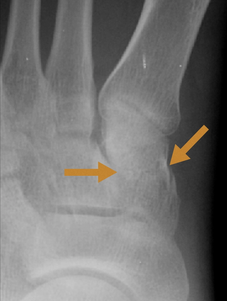Cuneiform fracture
Editor-In-Chief: Prab R Tumpati, MD
Obesity, Sleep & Internal medicine
Founder, WikiMD Wellnesspedia &
W8MD medical weight loss NYC and sleep center NYC
| Cuneiform fracture | |
|---|---|
| Synonyms | N/A |
| Pronounce | N/A |
| Specialty | N/A |
| Symptoms | Foot pain, swelling, difficulty bearing weight |
| Complications | Arthritis, chronic pain, foot deformity |
| Onset | Sudden, typically due to trauma |
| Duration | Varies, depending on treatment and severity |
| Types | N/A |
| Causes | Trauma, direct impact, twisting injury |
| Risks | High-impact sports, osteoporosis, falls |
| Diagnosis | Physical examination, X-ray, CT scan |
| Differential diagnosis | Lisfranc injury, navicular fracture, metatarsal fracture |
| Prevention | N/A |
| Treatment | Immobilization, casting, surgery |
| Medication | N/A |
| Prognosis | Generally good with appropriate treatment |
| Frequency | Rare |
| Deaths | N/A |
Cuneiform fracture refers to a type of bone fracture affecting the cuneiform bones of the foot. The human foot contains three cuneiform bones, named the medial, intermediate, and lateral cuneiforms, which are located between the navicular bone and the first three metatarsal bones. These fractures are relatively rare and can occur due to direct impact or severe foot trauma, often seen in athletes or individuals involved in high-impact activities.
Causes[edit | edit source]
Cuneiform fractures typically result from direct trauma or compressive forces applied to the midfoot. This can happen through accidents such as falls from a height, motor vehicle collisions, or sports-related injuries. Indirect causes may include twisting injuries to the foot or overuse, leading to stress fractures in the cuneiform bones.
Symptoms[edit | edit source]
The primary symptoms of a cuneiform fracture include pain and swelling in the midfoot area, difficulty in bearing weight or walking, and sometimes bruising or deformity if the fracture is severe. The pain is usually localized over the dorsum of the foot and can be exacerbated by movement or pressure.
Diagnosis[edit | edit source]
Diagnosis of a cuneiform fracture involves a thorough medical history and physical examination, followed by imaging studies. X-rays are the first-line imaging technique used to visualize the fracture. In some cases, where the X-ray does not provide sufficient detail, CT scans or MRIs may be recommended to assess the extent of the injury and any associated damage to surrounding tissues.
Treatment[edit | edit source]
The treatment for a cuneiform fracture depends on the severity and type of the fracture. Non-displaced fractures, where the bone pieces remain aligned, can often be treated conservatively with immobilization. This involves the use of casts or boots to prevent movement and allow the bones to heal naturally. Weight-bearing activities are usually restricted for a period of time. Displaced fractures, where the bone pieces have moved out of alignment, may require surgical intervention. Surgery aims to realign the bones and fix them in place using pins, screws, or plates. This is followed by a period of immobilization and a gradual return to weight-bearing activities.
Recovery[edit | edit source]
Recovery times can vary significantly depending on the severity of the fracture and the treatment method. Non-surgical treatment may require several weeks to months of immobilization, followed by physical therapy to restore strength, flexibility, and range of motion. Surgical treatment may involve a longer recovery period, with an emphasis on rehabilitation to ensure proper healing and functionality of the foot.
Prevention[edit | edit source]
Preventing cuneiform fractures involves minimizing the risk factors associated with foot injuries. This includes wearing appropriate footwear, especially during high-impact sports, maintaining good physical conditioning, and avoiding activities that put excessive stress on the feet.
Search WikiMD
Ad.Tired of being Overweight? Try W8MD's physician weight loss program.
Semaglutide (Ozempic / Wegovy and Tirzepatide (Mounjaro / Zepbound) available.
Advertise on WikiMD
|
WikiMD's Wellness Encyclopedia |
| Let Food Be Thy Medicine Medicine Thy Food - Hippocrates |
Translate this page: - East Asian
中文,
日本,
한국어,
South Asian
हिन्दी,
தமிழ்,
తెలుగు,
Urdu,
ಕನ್ನಡ,
Southeast Asian
Indonesian,
Vietnamese,
Thai,
မြန်မာဘာသာ,
বাংলা
European
español,
Deutsch,
français,
Greek,
português do Brasil,
polski,
română,
русский,
Nederlands,
norsk,
svenska,
suomi,
Italian
Middle Eastern & African
عربى,
Turkish,
Persian,
Hebrew,
Afrikaans,
isiZulu,
Kiswahili,
Other
Bulgarian,
Hungarian,
Czech,
Swedish,
മലയാളം,
मराठी,
ਪੰਜਾਬੀ,
ગુજરાતી,
Portuguese,
Ukrainian
Medical Disclaimer: WikiMD is not a substitute for professional medical advice. The information on WikiMD is provided as an information resource only, may be incorrect, outdated or misleading, and is not to be used or relied on for any diagnostic or treatment purposes. Please consult your health care provider before making any healthcare decisions or for guidance about a specific medical condition. WikiMD expressly disclaims responsibility, and shall have no liability, for any damages, loss, injury, or liability whatsoever suffered as a result of your reliance on the information contained in this site. By visiting this site you agree to the foregoing terms and conditions, which may from time to time be changed or supplemented by WikiMD. If you do not agree to the foregoing terms and conditions, you should not enter or use this site. See full disclaimer.
Credits:Most images are courtesy of Wikimedia commons, and templates, categories Wikipedia, licensed under CC BY SA or similar.
Contributors: Prab R. Tumpati, MD


